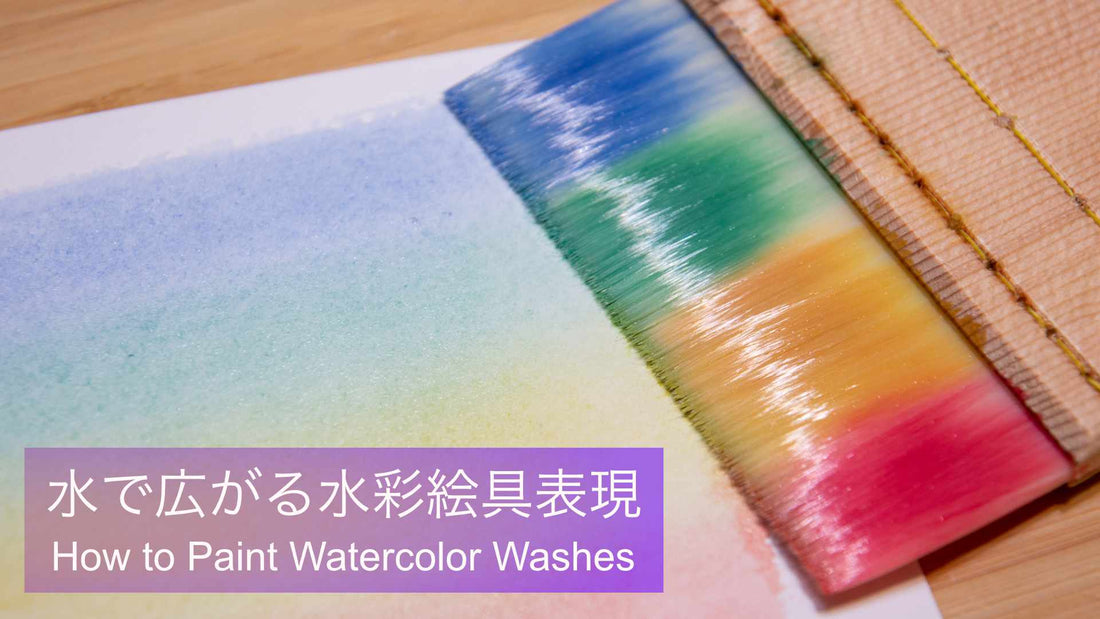Transparent watercolors are paints made with the natural resin of acacia as the binder.
This binder is water-soluble and highly transparent, and allows the colors to melt simply with the touch of a wet brush, which makes the paints easy to carry outdoors as watercolor pans or mix colors on paper.
On the other hand, oil or acrylic paints do not have such unique characteristics.
In Japan, watercolors are often used in school art education, so many of you may have painted with them at least once.
In this article, I would like to focus on the "water solubility" of watercolors.
As mentioned earlier, watercolor paints blend well with water and can instantly create gradations from light to dark. However, once the paint dries and the pigments have been fixed on the paper, you cannot revive them. Therefore, sometimes it could be quite a headache when we paint on the wrong areas accidentally or couldn’t create the beautiful shading that we wanted.
For this reason, it is necessary to find a way to utilize the water.
Water is not only for diluting water-soluble paints but like the other "transparent paints" that are not in tubes or pans, you can create various expressions by controlling the water.
The first technique I would like to demonstrate is how to create gradation by applying water first on the substrate.
When using a large amount of water as l am showing here, if you use thick and good absorbent paper, it is unnecessary to mount it on panels or Urauchi backing.
There are many choices of papers for transparent watercolors, including the quality and whether it is dosa sized or not.
For this reason, I recommend the Bamboo Washi for Suibokuga (Japanese Ink Painting) Art Pad for beginners. It comes in sketchbook-type packaging and is suitable for carrying, it also allows you to paint without any Urauchi backing or dosa sizing.
In this article, I used ZECCHI transparent watercolors as my painting material.
First, use a brush that can paint over a large area to apply water on paper, and then apply watercolors before it dries. The trick is to apply your brush tip to the wet surface gently as if you were “releasing” the paint rather than “painting” it.

Then, you may paint the color from the opposite direction as well.
As on the right side, apply the color by gently moving your brush on the paper without rushing yourself.

Tadaa, here is the result!
I did not move the brush widely to blur the color, resulting in these random color shades. Furthermore, since the paint does not go out from where water is applied, I can change the shades with your brush strokes.

【Art Materials Used】
Substrate: Bamboo Washi for Watercolor Art Pad
Color Material: Zecchi Watercolors (Scarlet Lake, Primary Blue)
Here is another experiment I did with the same technique.
Such huge changing shades cannot be created by one brushwork.

【Art Materials Used】
Substrate: Bamboo Washi for Watercolor Art Pad
Color Material: Zecchi Watercolors (Ultramarine Blue Deep, Primary Blue)
Moreover, there is another way to create a smooth gradation with a wide brush stroke by applying the color directly to the brush.
For example, when using a single color, gradation can be made if you only apply the paint on one side of the brush and paint on paper. However, it is better to adjust the thickness and brightness of the paint before applying it to the paper.
I used a Zecchi watercolor pan but I recommend using watercolors other than the solid type for this technique.


【Art Materials Used】
Substrate: Bamboo Washi for Watercolor Art Pad
Color Material: Zecchi Watercolor (Primary Blue)
Moreover, it is also possible to create gradations with multiple colors.
First, paint the colors you like onto a dry paintbrush.
For this type of technique, I recommend using nylon brushes which can hold less water and have more stiffness compared to goat hair brushes. The paint I used this time is called Gansai which is a watercolor palette that is inspired by Asian art and scenery.
Gansai is a mixture of pigments, animal glue, and gum arabic that are solidified and put in cases, therefore, it can be used like other transparent watercolors.
Apply each color with a paintbrush like a Saishiki brush on the flat brush.
Even if a color blends into the color next to it, that will not affect when it is painted on paper, so make sure to apply enough paint.

Then, when painting with a flat brush has colors on its bristle, the soft gradation appears. It will look almost like pastel colors spread with fingers on the surface.

【Art Materials Used】
Substrate: Bamboo Washi for Watercolor Art Pad
Color Material: Gansai
In these ways, paints that dissolve with water including transparent watercolors can create different expressions by simply changing the painting process just a little.
Therefore, perhaps you may find a new way to enjoy playing with paints and creating color gradations with watercolors?
Translated by Atsumi Okano and Nelson Hor Ee Herng
PIGMENT TOKYO Art Materials Experts




